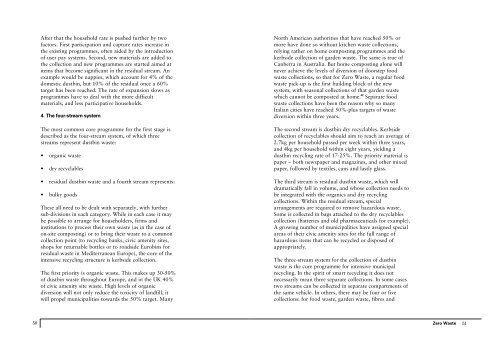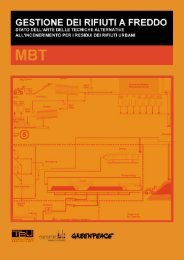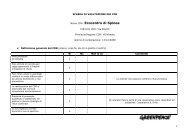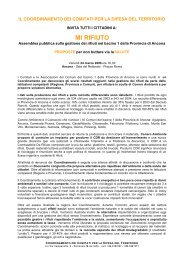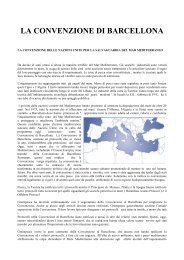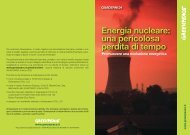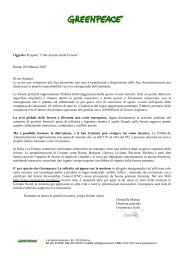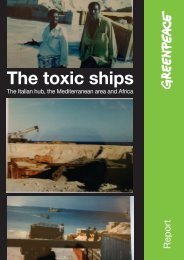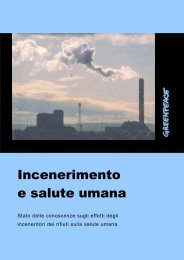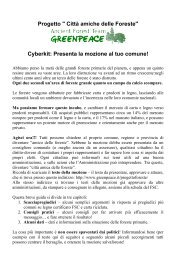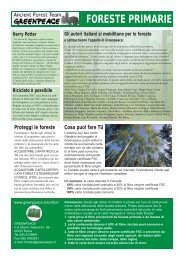Zero Waste by Robin Murray, Greenpeace Environmental Trust 2002
Zero Waste by Robin Murray, Greenpeace Environmental Trust 2002
Zero Waste by Robin Murray, Greenpeace Environmental Trust 2002
Create successful ePaper yourself
Turn your PDF publications into a flip-book with our unique Google optimized e-Paper software.
After that the household rate is pushed further <strong>by</strong> two<br />
factors. First participation and capture rates increase in<br />
the existing programmes, often aided <strong>by</strong> the introduction<br />
of user pay systems. Second, new materials are added to<br />
the collection and new programmes are started aimed at<br />
items that become significant in the residual stream. An<br />
example would be nappies, which account for 4% of the<br />
domestic dustbin, but 10% of the residual once a 60%<br />
target has been reached. The rate of expansion slows as<br />
programmes have to deal with the more difficult<br />
materials, and less participative households.<br />
4. The four-stream system<br />
The most common core programme for the first stage is<br />
described as the four-stream system, of which three<br />
streams represent dustbin waste:<br />
• organic waste<br />
• dry recyclables<br />
• residual dustbin waste and a fourth stream represents:<br />
• bulky goods<br />
These all need to be dealt with separately, with further<br />
sub-divisions in each category. While in each case it may<br />
be possible to arrange for householders, firms and<br />
institutions to process their own waste (as in the case of<br />
on-site composting) or to bring their waste to a common<br />
collection point (to recycling banks, civic amenity sites,<br />
shops for returnable bottles or to roadside Eurobins for<br />
residual waste in Mediterranean Europe), the core of the<br />
intensive recycling structure is kerbside collection.<br />
The first priority is organic waste. This makes up 30-50%<br />
of dustbin waste throughout Europe, and in the UK 40%<br />
of civic amenity site waste. High levels of organic<br />
diversion will not only reduce the toxicity of landfill, it<br />
will propel municipalities towards the 50% target. Many<br />
North American authorities that have reached 50% or<br />
more have done so without kitchen waste collections,<br />
relying rather on home composting programmes and the<br />
kerbside collection of garden waste. The same is true of<br />
Canberra in Australia. But home composting alone will<br />
never achieve the levels of diversion of doorstep food<br />
waste collections, so that for <strong>Zero</strong> <strong>Waste</strong>, a regular food<br />
waste pick-up is the first building block of the new<br />
system, with seasonal collections of that garden waste<br />
which cannot be composted at home. 42 Separate food<br />
waste collections have been the reason why so many<br />
Italian cities have reached 50%-plus targets of waste<br />
diversion within three years.<br />
The second stream is dustbin dry recyclables. Kerbside<br />
collection of recyclables should aim to reach an average of<br />
2.7kg per household passed per week within three years,<br />
and 4kg per household within eight years, yielding a<br />
dustbin recycling rate of 17-25%. The priority material is<br />
paper – both newspaper and magazines, and other mixed<br />
paper, followed <strong>by</strong> textiles, cans and lastly glass.<br />
The third stream is residual dustbin waste, which will<br />
dramatically fall in volume, and whose collection needs to<br />
be integrated with the organics and dry recycling<br />
collections. Within the residual stream, special<br />
arrangements are required to remove hazardous waste.<br />
Some is collected in bags attached to the dry recyclables<br />
collection (batteries and old pharmaceuticals for example).<br />
A growing number of municipalities have assigned special<br />
areas of their civic amenity sites for the full range of<br />
hazardous items that can be recycled or disposed of<br />
appropriately.<br />
The three-stream system for the collection of dustbin<br />
waste is the core programme for intensive municipal<br />
recycling. In the spirit of smart recycling it does not<br />
necessarily mean three separate collections. In some cases<br />
two streams can be collected in separate compartments of<br />
the same vehicle. In others, there may be four or five<br />
collections: for food waste, garden waste, fibres and<br />
50<br />
<strong>Zero</strong> <strong>Waste</strong><br />
51


